Search engine optimisation (SEO) was my first job out of college, mainly writing SEO-friendly content. Like any fresh degree holder entering the workforce, I was none the wiser about the industry I got myself into. I hadn’t even heard of SEO until I wrote my first several articles, and you bet that I hadn’t known its dos and don’ts. Back then, one of the things I did was set up articles for spinning with tools, which looked like this.

(For the record, I only used an excerpt from one of Aaron’s posts as an example – that one was not made with article spinning.)
This painstaking process took me and my fellow writers the better part of our day, but it would generate multiple versions of the same article. SEO practices back then were all about generating volume.
As much as it pains me to say this now, I grew more disgusted with the practice the more I did it. It was only when I joined the NO-BS family that I learned that my disgust wasn’t misplaced. It’s nothing short of glorified plagiarism – unacceptable to one with a journalism degree, let alone to post-Penguin Google.
Under NO-BS’s (and later Pursuit Digital’s) guidance, I invested in learning more about SEO. It isn’t a bad industry, as my naïve younger self once thought, but there’s a strong need to inform others about what to and not to do. Whether you’re a newcomer or have been in the business for the longest time, this comprehensive guide is for you.
What is SEO?
A query like ‘What is SEO’ is nothing a quick Google search can’t answer. You’ll get most of everything you need to know on the first page, from being a set of practices for improving a website’s search visibility to helping search engines understand content.
But it got me thinking. This is an ‘ultimate guide’ to SEO, meaning people who know next to nothing about SEO will be looking at this too. Jargon right off the bat is a great way to leave readers more confused (we’ll be getting to the technical weeds later, anyway). Fortunately, after scouring the internet, I found a good way to explain SEO like you’re five.

In soccer (or football, depending on where you live), scoring involves leading the ball towards the goal with your legs, head, or torso. Only the goalkeeper can use their hands to prevent the other team from scoring. This basic rule prompts players to work their legs in leading and passing the ball while protecting it from intercepts.
SEO follows a similar analogy. Search engines set rules for indexing content for every keyword, prompting websites to find ways to get their content to appear. Creating useful content is akin to using only your legs, while article spinning is like playing soccer with your hands.
How does SEO work?
Some explanations about SEO that I came across described it as ‘gaming’ or ‘manipulating’ search engine algorithms to appear favourably on search results. While there’s some truth to this, these terms aren’t the best way to define SEO.
For starters, Google uses the term ‘search engine manipulation,’ which dates back to 2014. It gained considerable attention in 2016 after it faced a lawsuit against a company it believed to be engaged in such a practice. Search engine manipulation is more commonly known as webspam, but you can see that SEO isn’t completely implicit in manipulating algorithms.
By that, I mean that Google recognises some form of gaming, provided it adheres to its Search Essentials. Formerly known as the Webmaster Guidelines, Search Essentials is the rulebook with which websites must comply by any means necessary. That also means being shrewd with how they generate their content.
As such, I prefer describing SEO – namely post-Penguin SEO – as ‘tweaking’ content to help trigger part of the algorithm that rewards compliance with the guidelines. As you’ll learn later, this approach is the slowest route to success, but it’s better than not moving at all.
On-page SEO
Current SEO practices are classified as either on-page or off-page SEO. As these terms imply, on-page SEO focuses on a website’s internal pages, whereas off-page SEO focuses on media beyond the target website. Both are equally important but for different reasons.
Let’s start with the former. On-page SEO is crucial because of how search engines index web pages. They release crawlers or ‘spiders’ to scour the internet for up-to-date content, ranking them favourably if they deem it useful in a user’s search. Optimising web pages involves creating a road network for crawlers to travel between pages.
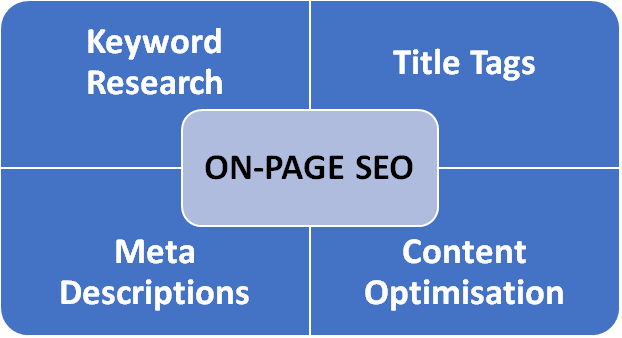
There are over a dozen practices related to on-page SEO. Here are a few fundamental ones.
- Keyword researchEven the most well-written article or blog post won’t matter if it struggles to be visible on everyone’s radar. That’s not a one-off thing – nine out of ten pages don’t get so much as a peep from visitors.
Keyword research lets you discover the keywords or queries people are searching for, but that alone won’t be enough. Naturally, generic queries like ‘golf club’ or ‘soccer shoes’ exist but are top-heavy with competition. Ranking content for them is virtually impossible.
That’s why proper keyword research takes this one step further. It discovers the keywords or queries people are searching for by looking at what competitors are ranking for. Most of the time, they’re narrowed-down queries like ‘best golf club for beginners’ or ‘soccer shoes for synthetic turf.’ Remember, most people on Google search for solutions, not products.
- Title tagsFirst impressions matter, and that’s no different in SEO. When a search engine crawls a page, among the first things it’ll encounter are what I refer to as the ‘meta duo.’

The first is the title tag, the header appearing in every search result. It gives a concise idea of the page’s content, similar to how a news headline works. We can’t expect the algorithm to start speaking human anytime soon, so title tags are a good way to communicate to the search engine what the content’s all about.
The tag appears not only on the results page but also on the web browser tab and the external link shared on social media. While there’s no limit on how long it can be, keeping it between 50 and 60 characters is ideal for a better user experience.
- Meta descriptions other half of the meta duo is the meta description, the string of text below the title tag.

Google clarified in 2009 that meta descriptions aren’t among its ranking factors, and that’s still true today. However, many SEO experts agree that a well-written meta description is a boon to a page’s click-through rate (CTR). A higher CTR translates to increased awareness for your brand, and that’s a good thing in SEO.
The meta description also appears in the external link shared on social media. To prevent it from being cut off, Google advises keeping the length up to 152 characters for desktop and 105 characters for mobile.
- Content optimisation When you’ve done your keyword and topic research, the next step is to create content using the data from that research. By optimising your content, you can maximise its reach to help rank it in queries and convert readers to paying customers.
Content optimisation comes as a no-brainer. In an age when the solutions to most problems are a Google away, people expect adequate information to be available when they conduct a search, more so when they ‘feel lucky.’ There are a dozen ways to do this, but that warrants its own blog post.
Regardless, one thing you should know is that there’s a link between well-written content and search ranking. SEMrush studied around 24,000 articles ranking in the top 10 search results and found that one-third of top-ranked articles scored high marks in consistency, originality, readability, and tone of voice.
- Off-page SEO Off-page SEO doesn’t influence rankings as directly as on-page SEO, but it helps in another way. To understand its impact, let me introduce you to Google E-A-T. Or should I say E-E-A-T?
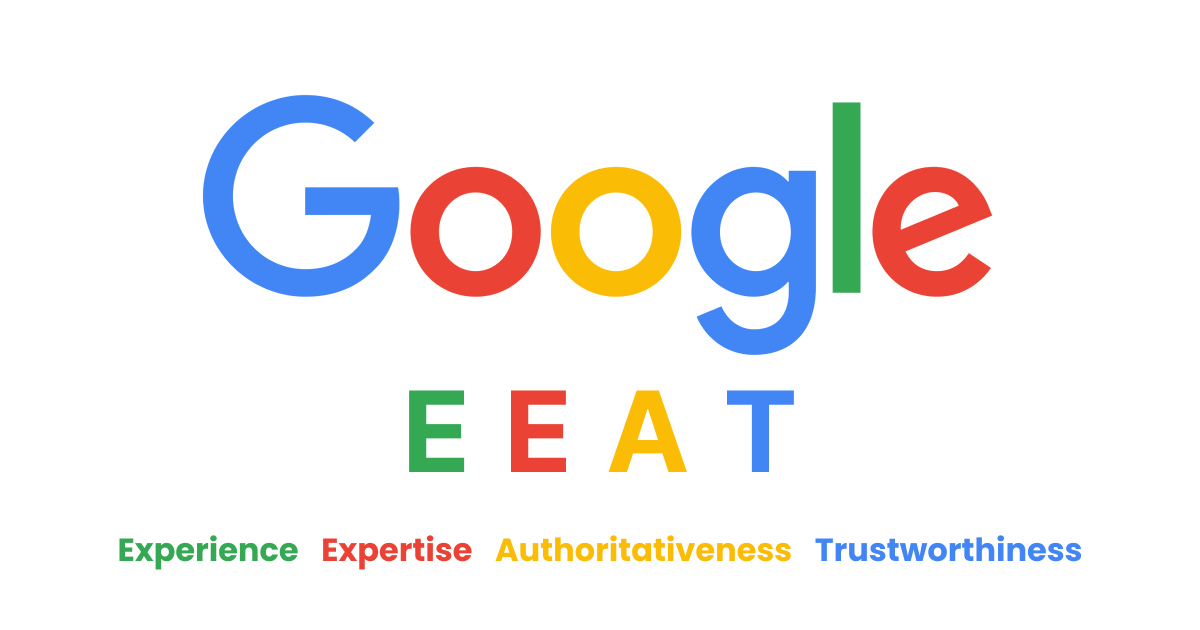
You see, Google determines content quality using three factors: expertise, authoritativeness, and trustworthiness – hence, E-A-T. Do it while enjoying a burger if you must, but the search engine giant requires content to show that:
- the author knows what they’re talking about;
- the website shows that it’s an authority on the topic; and
- visitors feel peace of mind when perusing the content.
Then, before the end of 2022, Google added another E to the acronym to prioritise experience as much as the other three. This factor refers to the content creator’s first-hand experience using the product or service. The rationale is simple: you’d trust someone who’s using or has used it before more than someone who hasn’t.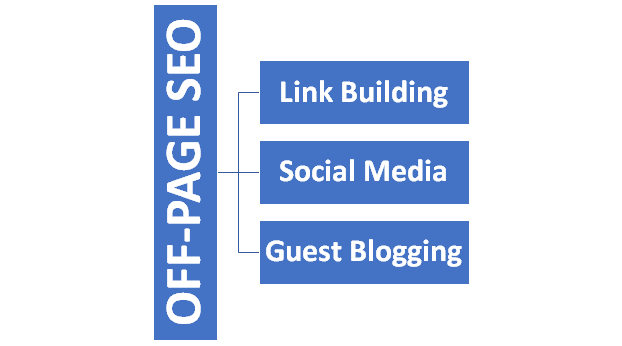
What does all this have to do with off-page SEO? It builds a brand’s reputation by vouching for its E-E-A-T. The following practices explain how.
- Link building I probably don’t need to go in-depth about link building. The NO-BS blog page already has several articles dedicated to the subject, which you should check out. But because this is the ultimate guide to SEO, leaving the basics of link building out won’t do the guide justice.
Google isn’t keen on sharing its list of ranking factors, but you can take its word when it says backlinks are one of them. They serve as a page’s vote of confidence, especially when a high-authority website deems it so. The more high-quality backlinks a page has, the more likely it’ll rank higher in search results.
You don’t beg for, borrow, or steal backlinks (otherwise, Google help you). You can ask for some through guest posting (more on this later), broken link replacement, or link exchanges, among other tactics. But while the most rewarding backlinks are earned, some optimisation is necessary to ensure it reaches as many people as possible.
- Social media If your business doesn’t have a social media account or page, it’s missing out on juicy traffic. Over half of people worldwide use social media, and that figure’s projected to rise in the next several years. That isn’t even accounting for the average internet user spending 2.5 of their 7 or 8 hours on the internet browsing social media.
Know that people will only go to Google when they feel a need to know something essential. If they find that in their social media news feeds, there’s almost no need for them to resort to search engines. That’s why maintaining a social media presence is just as vital as optimising pages to be SEO-friendly, even if it doesn’t influence rankings.
At the bare minimum, your business should establish a presence on two of the world’s largest platforms: Facebook and Twitter. If you plan to produce video content, consider setting up an account on YouTube. Other ways to harness social media include answering niche-relevant queries on discussion boards and forums.
- Guest blogging/posting Guest blogging or posting is the act of getting your article published on a website you don’t own. You can say it’s the cornerstone of any off-page SEO strategy, not to mention the core of the NO-BS link-building system.
Regardless of what you heard from Matt Cutts several years ago, guest blogging is alive and kicking. In fact, the whole ‘guest blogging is done’ assertion that sent the SEO industry into a tizzy is a misinterpretation. He was referring to the old way of creating guest blogs, which involved propagating backlinks irrespective of quality.
Granted, the shift has made doing SEO via guest blogging more difficult. But what if I told you that guest blogging was never designed for earning backlinks? Yes, it sounds contrary to what I just said earlier, but earning backlinks is more of a side effect in this case. You write guest posts primarily to let people know you’re an expert in a niche.
Now let’s try putting two and two together. Off-page SEO helps fulfil Google’s requirement for expertise and authority in content. Provided said content contains one link to the business’s site, search engines will crawl that link. That’s where on-page SEO comes in, ensuring the crawlers reach every nook and cranny of the site for its internal pages to be indexed.
SEO tools
SEO also comes with another welcome benefit: it technically costs nothing. Sure, there are things like paid links and premium tools, but many businesses can get by with free tools. Many analytic suites like Ahrefs and SEMrush offer free versions of their tools, albeit limited in how much data they can display at a time.
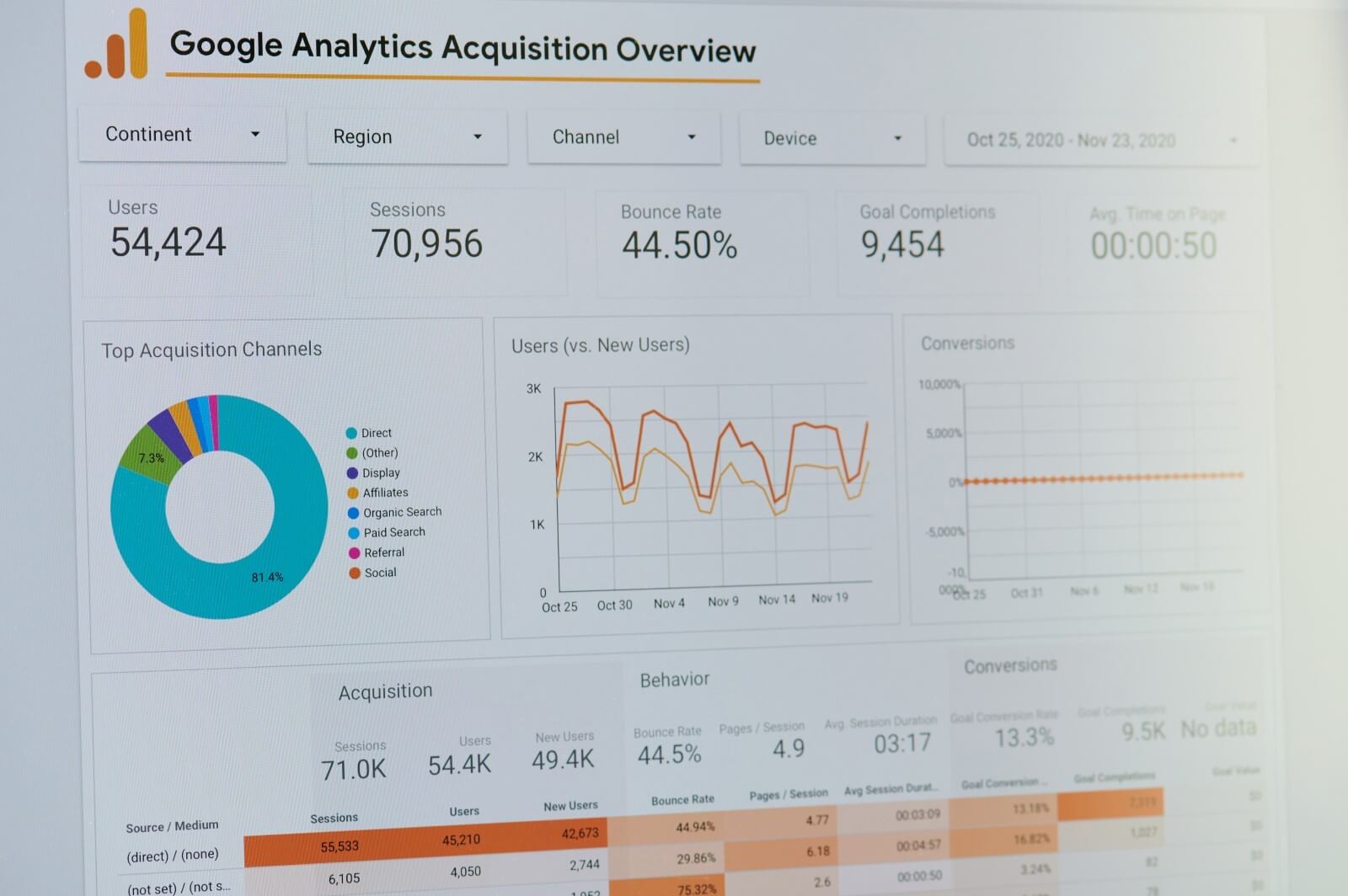
The list below shows some of the tools commonly found in professionals’ SEO toolboxes. You don’t have to get all of them for your toolbox, but having a complete set helps.
- Website analytics
- Backlink sources
- Keyword research and difficulty checker
- Backlink update alerts
- Search results tracking
That said, if you want everything and more in one program, including professional help, it’ll cost a pretty penny. Then again, investing in SEO solutions may be the better move, given that SEO is a complicated subject. Trust me, this guide is only scratching the surface, and delving deeper into every topic here would make it way longer than it should be.
SEO tips
SEO advice is a dime a dozen, but going through each one warrants its own article. Instead, I’ll provide tips you should keep in mind throughout the phases of your SEO strategy.
- Search intent always takes priority What comes to mind when a person searches for ‘best flagship smartphones 2023’? Believe it or not, some businesses make the mistake of pushing their product pages as their answer to the query. As the image below shows, product pages aren’t what most people are looking for.
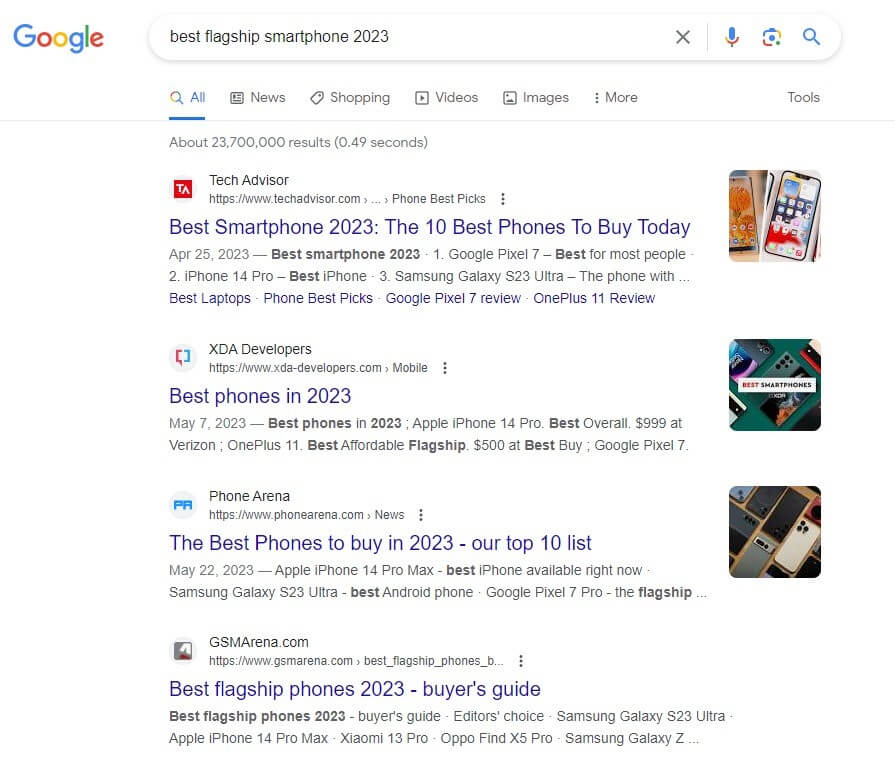
Google doesn’t always get search intent right, but knowing the nature of search results for specific queries is a step closer to SEO success. In this example, ranking for ‘best flagship smartphones 2023’ requires creating a list-type article (or a ‘listicle’). Fortunately, assessing search intent is as simple as running a search yourself.
- Position keywords strategically As I discussed previously, the meta duo is among the first things Google sees when indexing a page. Placing a keyword in the title tag and meta description makes its indexing job much easier. If possible, a keyword mentioned in the first 100 words of an article also helps.
More importantly, avoid going overboard with keyword usage. Search engines today no longer rely on term frequency for ranking, even considering keyword stuffing downright spam. Because of that, some websites try to limit keyword density to single-digit rates.
- Take advantage of auto-suggest Advances in search engine algorithms gave us nifty features in search engines, one of which is auto-suggest (also known as autocomplete suggestions). It isn’t rocket science – just type your search term and see what it suggests.
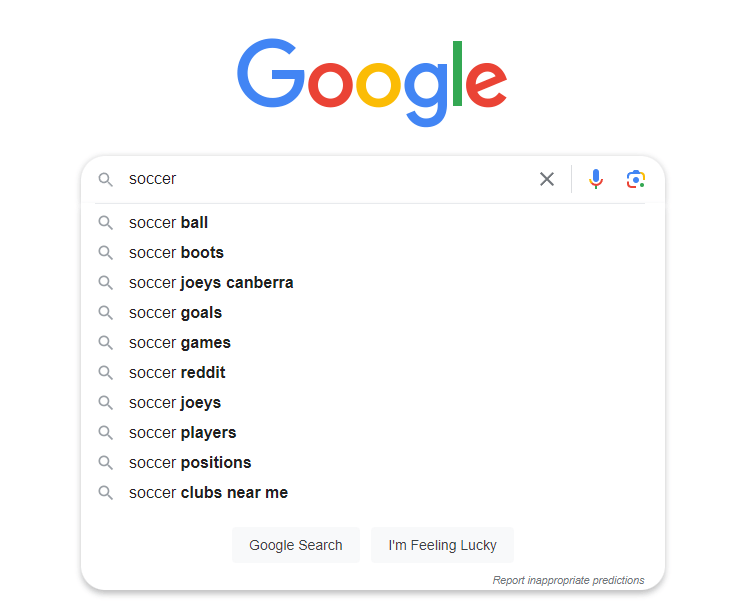
As far as Google is concerned, auto-suggest is a great way to identify search intent. This is because the suggestions are based on actual searches done by users in the past. The entries imply that many people searched for these keywords, which translates to SEO opportunities.
Auto-suggest is also a feature in other search engines and sites with search functions. Give it a try with Bing, Wikipedia, and YouTube.
SEO myths and misconceptions
If Cutts’ ‘guest blogging is dead’ debacle is any indication, SEO has its fair share of myths and misconceptions. I don’t blame you if you’ve fallen for some of them. As I said just now, SEO is complicated and changes on the fly. Just look at what happened to keyword stuffing – the norm one day and branded a black hat the next.
Regardless, the following myths and misconceptions must go away:
- SEO is dead Let’s start with a classic: SEO is dead. If we go by articles, SEO has died over 20 times as of 2020, and the killer is pretty much everything from Google Ads to Alexa. If we go by Ahrefs data on pages over time, it’s died around 5,000 times since 2016.
It’s gotten so ridiculous that it makes for a decent meme.
In all seriousness, the only way SEO will go away is if search engines go away too. I don’t see that happening anytime soon, even with artificial intelligence (AI) gaining ground in the industry. SEO will keep rewriting its doctrine as long as search engines continue improving or modifying their algorithms.
- You only need to do SEO once This one is relatively easy to dispel. Your business isn’t the only one doing SEO. The effects of proper SEO don’t last forever, especially when everyone else is jostling for the coveted first-page positions. You can see your pages lose their rankings to others and link rot when you stop optimising them.
I like how Ahrefs referred to SEO as hitting the gym regularly. Start missing a few days, and you’ll regain the kilos you lost through sweat and tears. As a result, you’ll be forced to work much harder to lose that weight gain again.
- SEO takes effect instantlyThis one might be primarily responsible for festering animosity and frustration towards SEO. Sadly, promises of better rankings in search results are everywhere in the industry. The truth can’t guarantee such a thing because too many factors are in the way.
One such factor is the website’s age. Older websites have had months, if not years, to accrue hundreds or thousands of backlinks, meaning their pages will rank better than those from a website that just went live a few weeks ago. If I have to peg a number, six months is often the sweet spot, but know that it can take upwards of a year, provided consistent SEO.
SEO trends
Dr. Peter Myers, a cognitive psychologist and Moz’s resident marketing scientist, gathered data on Google’s launches or updates between 2014 and 2022, and he discovered something fascinating. The ‘algorithm temperature,’ how erratic search changes have been, has never been hotter last year than in the previous ones, even surpassing the Panda and Penguin purges.
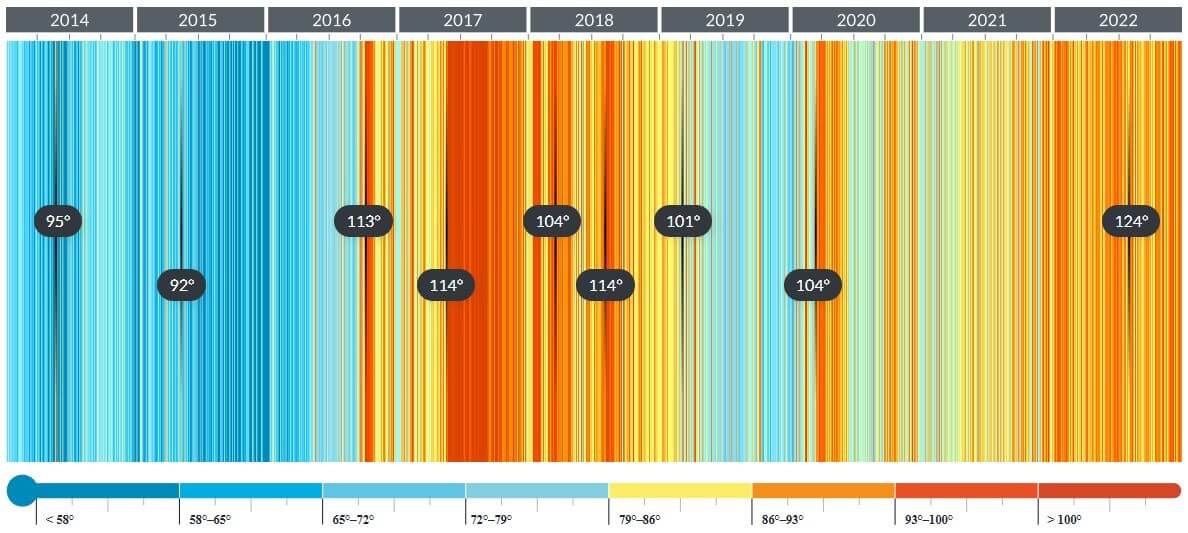
What does all this mean? Simple: you don’t want to be kept out of the loop in SEO. The weather, as Dr. Myers called it, results from changes in consumer behaviour, and businesses know well to keep an eye on it. Below are the latest trends that are rewriting the SEO rulebook.
- Artificial intelligence AI-assisted technologies like art generators and chatbots have been game changers in various industries, SEO included. I won’t be surprised if someone comes out saying AI will spell the death of SEO – again.
AI isn’t set to supplant SEO, nor was it created to do so. If anything, it has added new ways of using search engines, such as voice and image-based search. Chatbots also enable users to create content with a prompt a dozen words long, though I must advise against letting AI take over this aspect completely. One site learned that the hard way.
- Mobile-first search You might think, ‘That’s just standard search but on mobile devices. What’s the difference?’ Besides the medium for search, the differences are aplenty.
You’ve probably heard about how more people are using search engines via their phones and tablets, but do you know by how much? Statistics vary, but one estimate says twice as many users search with their mobile devices as with PCs. Some industries see higher volumes of mobile searches; food and beverage, for example, gets over 70% of searches from mobile.
It isn’t hard to see why mobile search gets much buzz. Mobile search enables customers to look up, say, the ‘best local restaurants’ or ‘must-visit attractions’ on the go. Google knows the wind’s blowing towards mobile searches, which is why it recommends maintaining mobile versions of websites for improved rankings.
- Increased Schema use Aaron discussed in a previous but must-read blog post about Google’s Schema system and how it can work wonders for SEO. But to give you a clear idea, everything you see in the screenshot below is Schema at work.
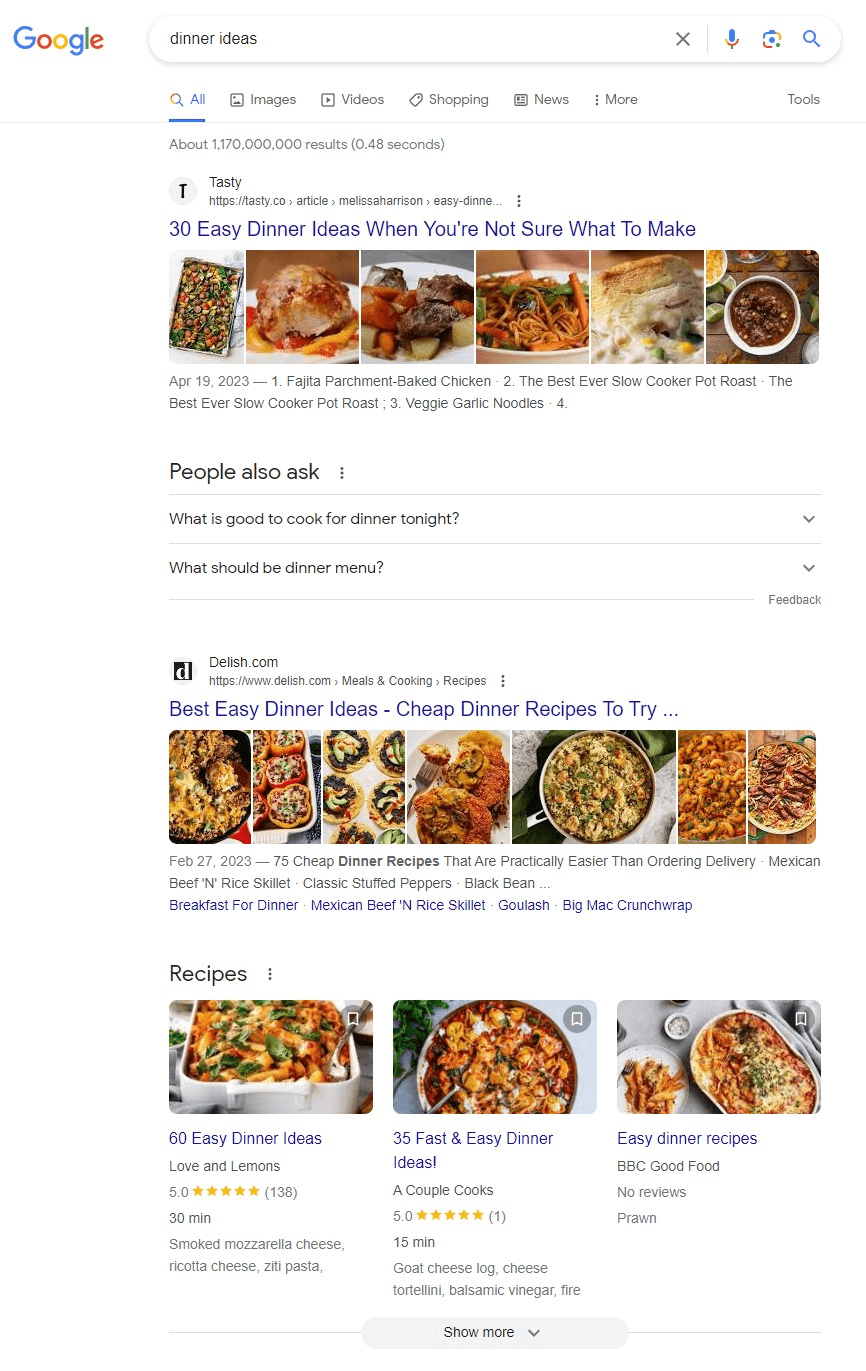
Schema structures search results into a more convenient format to enhance user experience. In the example above, I searched for ‘dinner ideas,’ so Google returned with links to recipes, answers to relevant questions, and mouth-watering images of food. I didn’t search ‘What’s good to cook for dinner tonight?’ but Google determined it’s relevant to my search intent.
As Schema finds its way into more queries, businesses are urged to harness it for their SEO strategies. This mainly falls under the purview of technical SEO, considering the amount of coding required to make it work.
Conclusion
If you’ve reached this part of the guide, then I appreciate you sticking with me until the end. That said, this is only an introduction of sorts to the complex world of SEO. More importantly, trends, rules, and tips can change in the blink of an eye. That’s why the learning journey does not end with reading this guide from start to finish.
I reckon there’s no end to learning – and that’s preferable. Humans grow with every success and failure in their lives, and it’s no different in optimising web pages and content. Never hesitate to broaden your horizons and keep on learning.
